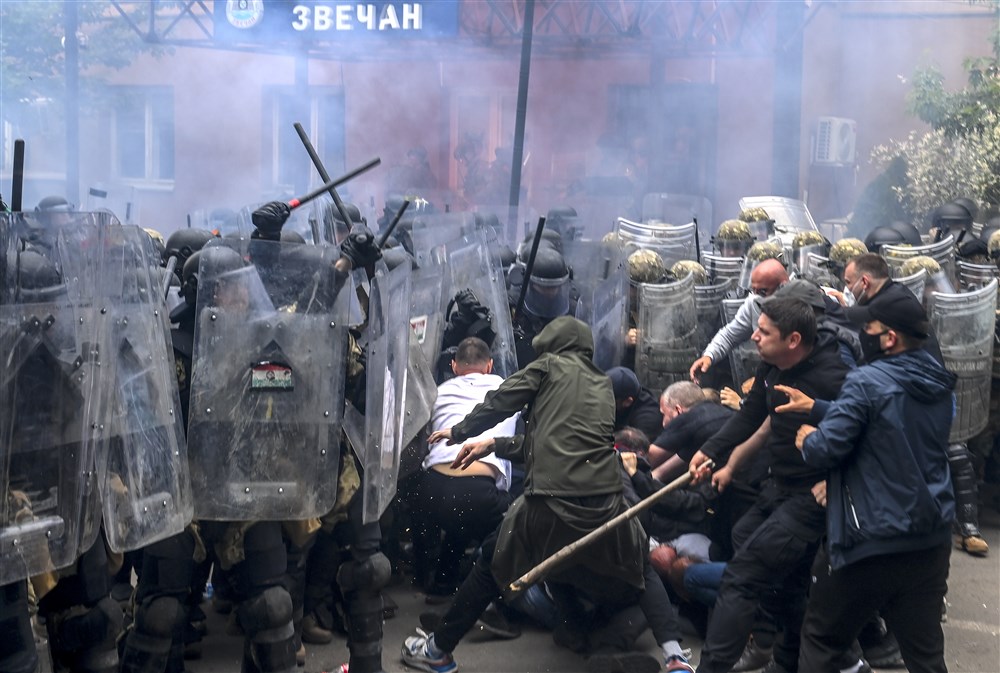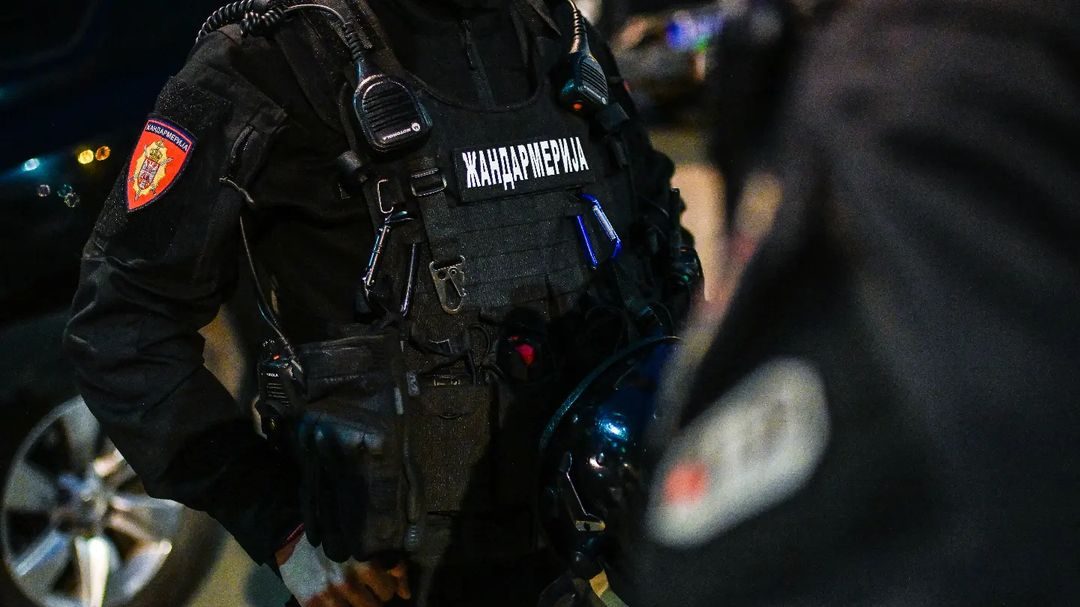As student protests in Serbia have gained domestic momentum and international attention, a critical cross-border perspective places these events within a broader regional and historical context, examining how the outcomes of the protests could affect developments related to neighboring Kosovo.
Following the collapse of the renovated railway station canopy in Novi Sad, Serbia in November 2024, massive protests and a collective institutional boycott have swept through the country. Universities have halted all activities and students have taken to the streets, joined by their professors, high school pupils, teachers, and other citizens.
On January 29, a two-day march began from Belgrade to Novi Sad, Serbia’s second-largest city. Students from Belgrade joined their peers in Novi Sad to mark three months since the tragedy by blocking three bridges over the Danube River as a sign of protest.
Two days prior, on January 27, a 24-hour blockade of the Autokomanda junction was held in Belgrade. It followed a successful nationwide strike on January 24. On December 22, 2024, around 100,000 people gathered at the Slavija Square in Belgrade, surpassing the size of the October 2000 protests that led to the fall of Slobodan Milosevic.
Waiting for the next move(s)

Soldiers of NATO-led international peacekeeping Kosovo Force clash with ethnic Serbs in front of the building of the municipality in Zvecan, Kosovo, 29 May 2023. Photo: EPA-/GEORGI LICOVSKI
Over the past years, Serbia has experienced ongoing internal turmoil. However, Aleksandar Vucic’s regime has never before faced this scale of contestation.
As this story unfolds, it remains to be seen whether the protests will turn into a general uprising, eventually fade away, or if there will be early elections that will result in the formation of a transitional government. Among the possible outcomes of the protests, regime change is one of the possibilities.
While there is hope within Serbia that the protests could lead to genuine change, the situation on the other side of the border is different. Serbia does not recognize Kosovo as a sovereign state.As such, a potential regime change in Serbia could have profound impacts on neighbouring Kosovo.
On one hand, there is the fear that the greater the threat to Vucic’s rule internally, the more he might attempt to divert attention by fabricating a nonexistent threat and once again using Kosovo as a political tool.
On the other hand, there is skepticism regarding the possibility of regime change in Belgrade. If a new force were to rise to power in Serbia, promising democratic reforms domestically while maintaining the same chauvinistic stance toward its neighbors, it would merely represent a reconfiguration of the same violent ideology under a different guise, giving the appearance of change without any real transformation. In such a reality, its credibility as a democratic force for potential domestic reforms would be undermined by continued external hostility.
Nationalistic banners featuring a map of Kosovo covered by the Serbian flag and the words “Nema predaje” (No surrender) stamped on them, reportedly seen in Beograd and Novi Sad, have caught the attention of many. Although nationalist symbols have not been a general feature of the protests or the student movement as a whole—since the latter remains focused mainly on issues like corruption and state capture, and until now has been careful to avoid apparent association with nationalist causes—they nevertheless remain problematic and evoke traumas and fears for Kosovo Albanians.
These concerns are legitimate in a context where Serbia never took responsibility for its role during the dissolution of Yugoslavia and its aftermath. Not only did Serbia not apologize, but it preserved the same ultranationalist stance in relation to its neighbors such as Kosovo and Bosnia and Herzegovina, where people continue to search for the remains of their loved ones who perished in the 1990s wars.
A potential regime change in Serbia or the emergence of a new political force that fails to acknowledge the multiple historical and political layers that exist between Serbia and its neighbors would not constitute true change for the region. If the commitment to opposing Aleksandar Vucic does not simultaneously serve as an anti-nationalist effort and a break from his divisive and aggressive policies, then any new political force would not truly represent a change of direction for the region, as it would merely preserve the same mindset and approach.
Students demanding change

Illustration. Photo: Instagram/@mupsrbije
Recently, Serbia has seen a series of massive protests. In August 2024, thousands of people protested against the Serbian government’s decision to reinstate Rio Tinto’s mining license for the lithium project in the Jadar Valley, which is located in the western part of the country. The protests were a continuation of the 2021 ecological demonstrations against lithium mining.
In May 2023, protests were sparked by a school shooting in Belgrade and the mass murders that took place simultaneously in two municipalities near the capital. In the same year, protests broke out following allegations of electoral fraud in the parliamentary and Belgrade City Assembly elections.
Civil society activists or opposition parties organized all of these protests. What sets the current massive protests apart is their highly decentralized nature.
So far, students are not allowing the politicization of the protests. Likewise, they have not allowed any civil organization or other groups to claim leadership. Moreover, they are refusing to negotiate with the government, insisting that their demands are met uncompromisingly.
These include transparency of all documentation regarding the reconstruction of the Novi Sad railway station; transparency regarding the identity and the initiation of criminal proceedings against individuals involved in physically attacking student protesters; the dismissal of criminal charges against student protesters; and a 20 percent budget increase for education.
The government initially responded with ongoing threats, attempts to bribe and divide the students, physical violence, accusations of treason, and efforts to portray the protests as externally orchestrated—scenarios already seen elsewhere, such as in Belarus in 2020 or Russia during the 2011-2012 protests.
Nevertheless, this only motivated the protesters to continue their struggle and attracted more supporters. Therefore, as a result of the protests, Serbia’s Prime Minister Milos Vucevic and Novi Sad’s mayor Milan Duric resigned.
These resignations do not mean much, however, considering that in a highly captured state and Serbia’s semi-authoritarian regime, power is concentrated in the hands of President Aleksandar Vucic. Vucic is merely using the departure of high-ranking figures such as Vucevic and Duric to create the impression that he is addressing students’ concerns and implementing change.
This move resembles more a political gesture than a genuine effort for reform. It is desperate, similar to the counter-rally staged in Jagodina on January 23 by the Serbian Progressive Party (SNS), which appeared to be another attempt for Vucic to assert legitimacy.
The European Union (EU) broke the silence concerning the protests only recently, with EU Commissioner for Enlargement Marta Kos acknowledging the situation through an open letter, though failing to address the causes that led to the massive protests, as well as EU’s responsibility as a potential mediator in a country that remains a candidate for EU membership and where democratic backsliding has been a persistent concern.
The Director-General for EU Neighbourhood and Enlargement Gert Jan Koopman visited Serbia on January 20, highlighting an “enlargement momentum” and “steady progress” in the country while disregarding the student’s protests. This fueled concerns about the EU’s failed conditionality in the region and growing Euroscepticism among local populations.
The EU’s silence on the current developments in Serbia, combined with the ongoing failure to implement EU-mediated agreements and Serbia’s persistent hostile stance toward Kosovo, contribute to growing insecurity, despite the impressive student mobilization and hopes of potential regime change. The idea of a democratic Serbia that moves away from its past and warmongering ideologies, while a welcomed prospect, is currently nothing more than a vague aspiration in Kosovo and beyond.
Gresa Hasa is an independent publicist, regularly contributing political commentary in Albanian, regional and often international media, with a focus on Balkan politics, social movements, nationalism, and gender issues. She currently resides in Vienna, Austria, where she continues her academic and professional career.
The opinions expressed are those of the author and do not necessarily reflect the views of BIRN.





